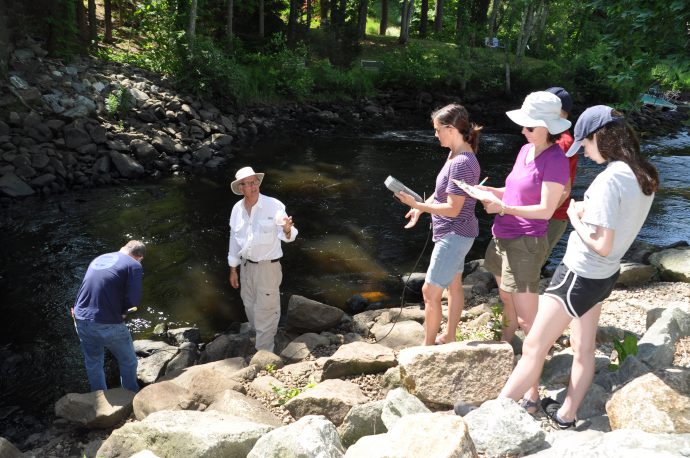2018 Stormwater Effects Evident in Summer Bacterial Counts
The North and South Rivers Watershed Association has been sampling water quality at 10 sites along the North & South Rivers for 24 years to evaluate the health of the rivers. This volunteer-driven program monitors the rivers every other week from the beginning of June to the end of August. We monitor for both swimming and shellfishing standards, each of which have specific concentrations of bacteria that are considered safe for humans. In 2017 we switched from testing fecal coliform at all sites to focusing on the areas where shellfish could be harvested (both in conditionally open areas as well as estuarine areas that still support shellfish but are prohibited). We expanded our enterococcus testing to include all ten sites, since that is the current standard for swimming in brackish and marine waters.
This summer, we found concentrations of enterococcus bacteria exceeding the swimming standards the majority of the time at either Washington Street Bridge or Willow Street Bridge, the two sites furthest upstream. These findings are consistent with past years. In addition, these higher counts all occurred after rain, with the exception of Willow Street Bridge on August 2nd. In comparison, July 5th was a dry sampling day with no enterococcus counts above the standard.
Three sampling sites in our rivers are located within seasonally opened shellfish beds. Currently the shellfish beds in the North and South Rivers are opened for recreational harvest between November 1st and May 31st. Among these three sites, North River Marine was above the standard on three dates and Damon’s Point was above the standard on two dates. All of these samples were collected on days with preceding rainfall.
Over the years bacteria counts have diminished in the rivers due to Title V septic improvements, implementation of town sewerage and improved treatment and minimization of stormwater runoff – all of which the NSRWA has advocated for using these data to make the case for reducing pollution sources.Thank you to the dedicated volunteers who helped with this program this year. If you are interested in volunteering next year please contact Sara Grady at sara@nsrwa.org or (781) 659-8168.
What are We Concerned About in the North and South Rivers?
Here in the North and South Rivers, our biggest concern is the bacteria brought in by stormwater runoff. In the past, poor treatment of wastewater would be to blame, but we have worked with surrounding towns to support their efforts to eliminate polluted discharge from their sewage treatment plants. Since then, bacterial counts have been dramatically decreased! But, the issue of bacteria brought in by stormwater runoff still remains, affecting our shellfish beds and the ability for our rivers to be fishable and swimmable throughout the year!
How Does Bacteria Affect Shellfish?
You know what they say: You are what you eat! In the case of shellfish living in bacteria polluted water, this spells trouble for those of us who enjoy fishing the shellfish beds in the North and South Rivers. Shellfish are filter-feeders. This means that they filter the water around them in order to feed off of the bacteria and microscopic algae natural in their waters. When harmful bacteria is introduced the shellfish consume it, and in turn, humans ingest it when we enjoy those shellfish for lunch. This can make us very sick depending on what bacteria was in the water. Thus, for our safety, when bacterial counts are high, the shellfish beds must be closed.
Volunteer to Monitor Water Quality
Please sign up for all available dates and we will schedule you! RiverWatch typically takes about 3-3.5 hours, and you will visit 10 sampling sites along the North and South Rivers.

